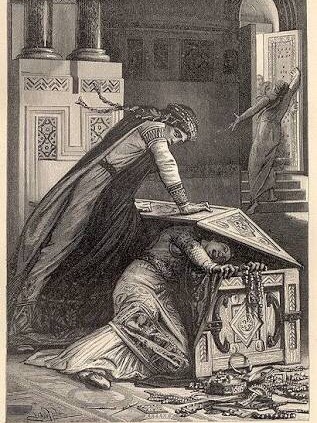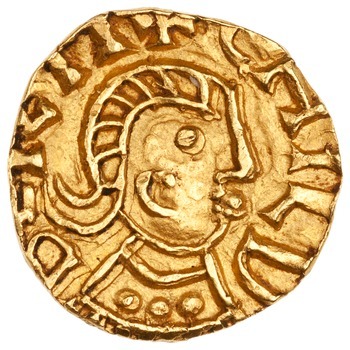#merovingian
Fredegund
Queen Consort of Neustria (western Francia)
Born ? - Died 597 CE
Claim to Fame: A brutal and formidable queen, best know for her forty year feud with her sister-in-law, Queen Brunhild of Austrasia.
Background: High-ranking women in Merovingian Gaul could hold substantial wealth and status in the fifth and sixth centuries which enabled them to exercise significant social, political and religious influence.
Born into a low-ranking family, Fredegund was a servant to the first wife of King Chilperic I of Neustria, Audovera. She seduced Chilperic and convinced him to divorce and expel Audovera. Chilperic then married a wealthy second wife, Galsuenda, but she soon died and was swiftly replaced as queen by Fredegund. Stories of Galsuenda’s death vary but it is believed that she spoke out against the immorality of Chilperic’s court so the King and his favourite mistress, Fredegund, had her strangled in bed. The powerful Queen Brunhild of Austrasia was both the sister-in-law of Chilperic (she was married to his brother) and the sister of Galsuenda. Brunhild’s fury at her sister’s death sparked a feud between the once unified houses of Austrasia and Neustria that spanned over forty years. The rivalry between Brunhild and Fredegund was particularly bitter and lead their families through generations of conflict.
Fredegund is represented in primary sources as a particularly violent woman who used her desirability to manipulate and corrupt those around her. She frequently contracted assassins as well as torturing, maiming and killing opponents. Among her many alleged misdeeds, Fredegund was suspected of ordering the assassination of Brunhild’s husband, Sigebert I, and attempting to assassinate Brunhild’s son Childebert II, her brother-in-law Guntram of Burgundy, and even Brunhild herself. In a jealous rage, she even attempted to murder her own daughter, Rigunth, by slamming the lid of a chest down on her neck as she reached for the jewelry inside. However, her violence was not limited to royal family members, and included a number of officials, clergymen and locals. In a classic example, Fredegund attempted to quell a dispute between kinsmen but ‘when she failed to reconcile them with gentle words she tamed them on both sides with the ax’ by inviting them to a feast and having them all murdered. Her formidable reputation served her well and she manipulated all levels of society through the fear of her fury.
When a dysentery epidemic struck her husband and two of her sons in 580 CE, Fredegund was plunged into remorse. Believing the epidemic was punishment for her sins, she burned unfair tax records and donated to the church and the poor after her sons succumbed to the disease.
In 584 CE, her husband, Chilperic, was mysteriously assassinated and Fredegund sought refuge in the Notre Dame de Paris cathedral. She died of natural causes 8 December 597 in Paris and is entombed in Saint Denis Basilica.
Several years after Fredegund’s death, her son Clothar II defeated Brunhild in battle and, despite the Queen being in her late sixties, he had her stretched on the rack for three days and then torn apart by four horses. Such was the bitterness of their familial enmity.
Note: The main source for Fredegund’s life is Gregory of Tours’ History of the Franks. Gregory was patronised by Queen Brunhild so his depictions of her qualities and the evils of her rival, Fredegund, are likely biased. Other sources recognise Fredegund’s brutality but treat her and Brunhild more equitably.
~ Much of this mini-bio is based on an essay of mine, so please PM me for sources.
Post link
“Duke Amalo sent his wife to another estate to attend to his interests, and fell in love with a certain free-born girl. And hen it was night and Amalo was drunk with wine he sent his men to seize the girl and bring her to his bed. She resisted and they brought her by force to his house, slapping her, and she was stained by a torrent of blood that ran from her nose. And even the bed of the duke mentioned above was made bloody by the stream. And he beat her, too, striking with his fists and cuffing her and beating her otherwise, and took her in his arms, but he was immediately overwhelmed with drowsiness and went to sleep. And she reached her hand over the man’s head and found his sword and drew it, and like Judith Holofernes struck the duke’s head a powerful blow. He cried out and his slaves came quickly. But when they wished to kill her he called out saying: “I beg you do not do it for it was I who did wrong in attempting to violate her chastity. Let her not perish for striving to keep her honor.” Saying this he died. And while the household was assembled weeping over him the the girl escaped from the house by God’s help and went in the night to the city of Chalon about thirtyfive miles away; and there she entered the church of Saint Marcellus and threw herself at the king’s feet and told all she had endured. Then the king was merciful and not only gave her her life but commanded that an order be given that she should be placed under his protection and should not suffer harm from any kinsman of the dead man. Moreover we know that by God’s help the girl’s chastity was not in any way violated by her savage ravisher.”
~ Gregory of Tours
Historia FrancorumIX:27,6th century CE

my final piece for the Light Grey Art Lab’s The End Is Night Exhibit.
“CHILDIRICI REGIS” is a visual exploration of Frankish King Childeric I’s burial treasure, which contained elaborate works of gold and garnet cloisonné jewelry. Most of this treasure no longer exists, save for two out of hundreds of cloisonné bees.
If you’d like to see the exhibition, it’s in-person in Light Grey Art Lab’s space in Minneapolis for a limited time OR view it on their website here. You can purchase individual prints (including this piece) or pre-order the book of the whole exhibition here
✦ find me on instagram @the.flightless.artist✦
THE END IS NIGH PRE-ORDER, A Curious Look at Death Throughout History
A Merovingian tremissis issued by King Childebert II, with his portrait on the front and a fantastical creature on the reverse.
Cast out of gold.
Made in the late 6th century by the Merovingian Franks at Tours in Gaul.
Currently held at the American Numismatic Society.
For those of you surprised at Tours issuing a coin for an Austrasian king. Firstly, after the death of Charibert I, king of Paris, his kingdom was divided between his 3 surviving brothers. Tours along Poitiers falling into Austrasian brother king Sigebert who is the faither of Childebert.
Secondly at the time Poitiers with Dowager Queen Radegund and Tours with repudiated Queen Ingoberga were probably safer as havens for these two ladies as Austrasian than with the Neustrian Chilperic who is not innocent in the death of Sigebert.
Thirdly, Tours was the capital of France before king Clovis moved it to Paris. Tours enjoyed a milder climate, was central and hosted the relics to the great late antiquity saint: Martin of Tours.
Post link



